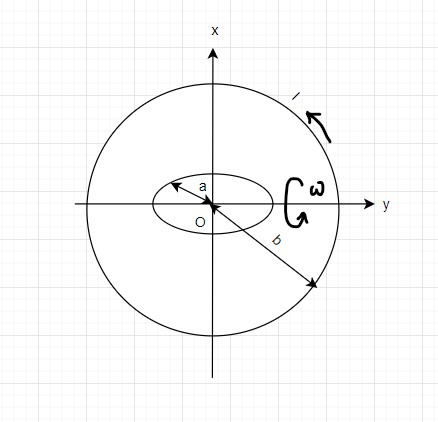Consider two concentric circular conducting turns, of radii a and b (? ≫ ?) as shown in the figure. At time t = 0, both turns coincide in the xy plane, and the turn of radius b remains at rest while the turn of radius a, resistance R, rotates around its diameter that coincides with the x axis with angular velocity constant ω. Suppose further that a constant current I flows in the loop of radius b, producing a uniform magnetic field in the region where the loop of radius a is located. a) Determine the current Ia induced in the loop of radius a, neglecting the effects of self-induction and determine the power dissipated in the loop of radius through its resistance. b) Determine the torque necessary to keep the turn of radius a rotating with angular velocity ω. c) Now consider the case in which the loop of radius a is at rest on the xy plane, with a constant current I circulating in it, while the loop of radius b rotates about its diameter that coincides with the x axis with angular velocity constant ω. Determine the force electromotive induced in the loop of radius b, neglecting the effects of self-induction.
Consider two concentric circular conducting turns, of radii a and b (? ≫ ?) as shown in the figure. At time t = 0, both turns coincide in the xy plane, and the turn of radius b remains at rest while the turn of radius a, resistance R, rotates around its diameter that coincides with the x axis with
a) Determine the current Ia induced in the loop of radius a, neglecting the effects of self-induction and determine the power dissipated in the loop of radius through its resistance.
b) Determine the torque necessary to keep the turn of radius a rotating with angular velocity ω.
c) Now consider the case in which the loop of radius a is at rest on the xy plane, with a constant current I circulating in it, while the loop of radius b rotates about its diameter that coincides with the x axis with angular velocity constant ω. Determine the force
electromotive induced in the loop of radius b, neglecting the effects of self-induction.

Two concentric circular conducting turns of radius, and , where
At time, both the circular loops coincide with each other at xy plane
At xy plane, turn of radius b is at rest, but turn of radius a, having resistance rotates with angular velocity .
Current flowing in loop of radius b is denoted as , it produces a uniform magnetic field in the turn of radius a.
TO DETERMINE:
(a) Current induced in loop of radius a and power dissipated in loop a.
(b) Torque needed to keep the turn of radius a rotating with angular velocity .
(c) Electromotive force induced in the loop of radius b.
DIAGRAM FOR THE GIVEN DATA:

(a) Current induced in loop of radius a and power dissipated in loop a:
We know, the current induced can be calculated by the uniform magnetic field produced due to coil of radius b
Therefore, Magnetic field produced in coil of radius a is calculated as,
Where, is the permeability of free space
is the current induced in loop of radius a
a is the radius of inner loop
Therefore from the above equation (1), current can be calculated as,
--------- (1)
Power dissipated in the loop of radius a is calculated by formula,
---------- (2)
where,
is the number of turns in coil of radius a,
is the magnetic field intensity
is the area of circular loop of radius a,
is the angular velocity of loop of radius a.
(b) Torque needed to keep the turn of radius a rotating with angular velocity :
To calculate the torque needed for rotating the turns of radius a, we can use the relation
-----------(3)
The ratio between the power dissipated in loop of radius a to the angular velocity of loop of radius a.
(c) Electromotive force induced in the loop of radius b:
The emf induced in loop of radius b is calculated using the formula,
Where,
is the magnetic flux produced in the coil of radius b,
is the magnetic field produced in coil of radius b by the coil of radius a.
is the area of the loop with radius a.
We know, ,
Hence,
Therefore,
Electromotive force produced in coil of radius b by the loop of radius a is given by,
-------- (4)
Step by step
Solved in 3 steps with 1 images
